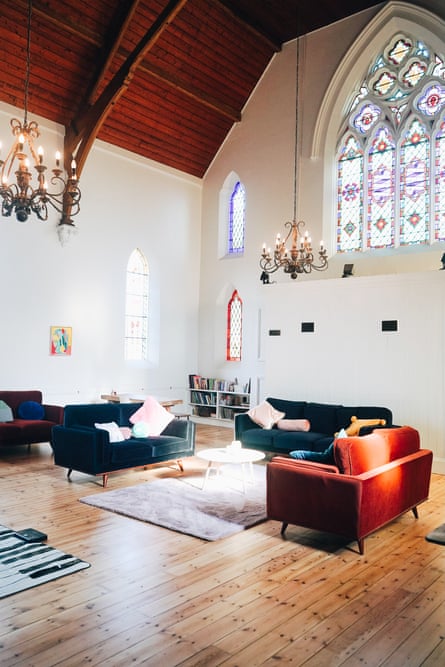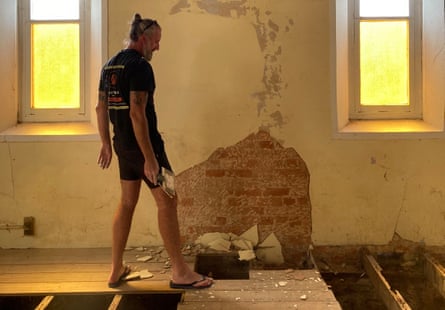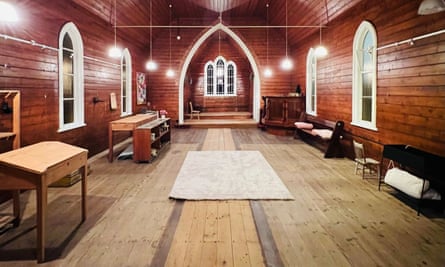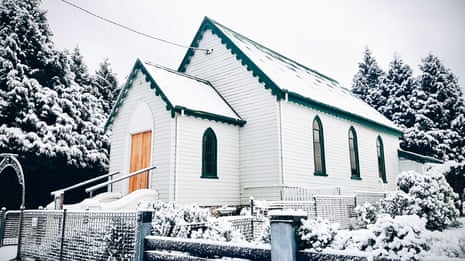Not far from Cradle Mountain in north-west Tasmania, and often surrounded by snow, sits a 140-year-old church that, until 2013, served as the St James Anglican church in the hamlet of Waratah.
The idyllic property was a once-in-a-lifetime find for owner Tracy Warren.
“It was such a beautiful, remote location with the few essentials you need,” she says.

For people seeking a slice of history, church do-over projects are an increasing source of fascination. Renovated into homes, accommodation and workspaces, these buildings have been restored and put to a new purpose – a process which can bring to light old tales from a time when they were the centre of the community.
“The first wedding in [St James] church saw the very young bride left at the altar when her groom didn’t show,” Warren says.
“A young man in the audience had always liked her, so he stood up and said he would like to marry her. They were happily married for over 60 years.”
St James church, now known as Waratah Chapel, was bought by private owners in 2015 for a mere $20,000 and restored as an art gallery, hosting exhibitions of relics and photographs.
Warren bought the property in 2021 for $125,000.

Built in 1880, the church still has its solid sandstone foundation and original bell, and features restored Baltic pine floorboards previously hidden by carpet.
Warren also owns the former Brickhill memorial church across the state at Campbell Town, which she purchased earlier this year from a couple who’d lived there for 18 years.
She has repurposed the Campbell Town church, 35 minutes from Launceston and already fully renovated, into a co-working space for women. It will also be open for weekend stays from September.
For church lovers, one gateway to ownership is a 20,000-member Facebook group, Churches for Sale Australia.
Hoping to find a rural church on a budget, the lawyer Cally Hannah created the page in 2015 to keep track of online church listings.
She has watched it expand and become a community that shares her enthusiasm, particularly during the past two years of the pandemic when large numbers of people relocated to rural areas.
With real estate agents, church owners and eager buyers in the group, properties don’t often stay on the market for long.


In January, the builder Heath Burton and mural artist Shannon Lamden bought a church and adjacent school hall in Carisbrook, a small town north-west of Melbourne, after discovering the online community.
The pair were initially looking for a weekender on the coast, but once they started seeing churches while driving through regional Victoria, they were hooked.
Built around 1914, the shell of the Carisbrook Uniting church is in perfect condition, but the floors in the church and the hall were left ridden with termites.
“The plan going into it was to salvage all the floorboards and reuse them,” says Burton, who was keen to preserve the existing materials and save money.
“Then we got in there and there was nothing that could be salvaged.”
Aided by Burton’s experience in restoring heritage-listed buildings, and his current work doing extensions on Melbourne terrace houses, the couple have been working hard and documenting their progress.
But as they turn Bible cupboards into bedroom doors and lay new floorboards, it is the character of the building – and the town – that has brought the project to life.

“You can’t stay here for half an hour without a neighbour coming in,” Lamden says.
“I was out the front and there was an old lady sitting in the car … so I went out to talk to her and she’d been going to that church since she was little.”
Not all churches come with low price tags. A recent listing at Gunning drew a lot of attention in the Facebook group and was sold at auction in July for $905,000; while a recent restoration in inner-city Melbourne went on the market with expressions of interest starting at $5.7m.
Renae Darlington, a real estate agent at Belle Property Hawkesbury, says the character of an old church appeals to people seeking out a point of difference.
St James Anglican church at Kurrajong, just outside Sydney, attracted an unprecedented amount of attention when listed for sale in October last year.
“The challenge that you have when you’re looking at selling something like that is, ‘what is it worth?’,” Darlington says.
The unique church, which had a price guide of about $700,000, ended up selling prior to auction for $1m.
With religious adherence in Australia in decline, according to the latest census, more churches are being sold.
Heritage grants from state governments can help bring these projects to life, with funding available for buildings listed on heritage registers. While criteria differs from state to state, such programs provide avenues for buyers to pursue historically informed restorations of churches and other character buildings.

Back in Tasmania, where wombats dutifully mow the lawn, Warren hopes the next owner of Waratah Chapel will fall in love with it as much as she did.
“There is something about the cathedral ceilings, the open space and the slim glass windows that make the world stop,” she says.
“You feel as though you are in a big secret vault but can still hear the world going by. It’s pretty special.”
